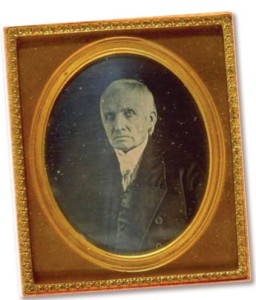By Dave Corrigan
(c) Connecticut Explored Inc. SUMMER 2013
Subscribe/Buy the Issue!
On September 2, 1802 Joel Root (1770- 1847) sailed out of New Haven Harbor on board the brig Huron in pursuit of a lucrative business in trading fur seal skins, for which there was great demand in China, and sea lion pelts, for which there was great demand in the U.S. He would venture around Cape Horn, bound forthe sealing grounds in the South Pacific, and three years later, with a full cargo of pelts, sail on to Canton, China, arriving in November 1805. From Canton the Huron proceeded around the Cape of Good Hope and along the west coast of Africa, reaching Hamburg, Germany in June 1806. From there, Root and the Huron sailed to St. Petersburg, Russia, finally returning to New Haven in October 1806, after a four year circumnavigation of the globe.
The Huron was one of a fleet of 20 sealing vessels based in New Haven that were active from the 1790s into the early 1800s. Sealing had developed as a money-making venture when, after the Revolutionary War secured U.S. independence, Great Britain enacted regulations barring American vessels from the West Indies trade. American merchants soon found coastal trade alone wasn’t sufficiently profitable. But in the early 1780s American merchants had accessed the Chinese market and learned that the pelts of fur seals were highly prized there, primarily as trimmings and linings for the winter clothing of China’s upper class. At the same time, demand for the skin of hair seals (sea lions) increased in America. Hair seal skins were tanned and used to make boots and shoes or as waterproof coverings for small wooden trunks. West Indies trade revived somewhat during the War of 1812 but declined afterward, as sealing, whaling, and an expanding cotton trade with Great Britain all proved more lucrative.
Both fur and hair seals were abundant on various islands off the coasts of Argentina, Chile, and Peru, and New England merchants and ship owners quickly moved to enter the emerging trade. Early in his Narrative of a Trading and Sealing Voyage in the Ship Huron (dictated to his daughter 36 years later, in 1840), Root explained how it was possible to obtain both kinds of skins and deliver them to the appropriate markets: “The first object of the voyage was to procure a cargo of hair seal skins, for the American market, after which I was authorized to stop at the island of Massafuero [400 miles off the coast of Chile, now part of the Juan Fernandez Islands], with ten or twelve hands on board the ship, for the purpose of procuring a cargo of fur seal skins for the China market, while the ship returned home with the hair seal skins.” The Huron would then return to Masafuera [as it was more typically spelled; it was also called Mas Afuera and is now Alexander Selkirk Island]and proceed to China.
Edward Atwater, in his 1887 History of the City of New Haven, described New Haven’s “Sealing Fleet” as a “prominent part of the (town’s) maritime interests” and an adjunct of the legendary China Trade. Atwater noted that many of the sailors on the sealing ships were the scions of prominent merchant families beginning to learn the family business. Other young men and ordinary sailors signed on in the hope that their share of the profits from the voyage would be enough for them to purchase a farm upon their return. Yet others, according to Atwater, sought to “increase their worldly store and to see foreign lands; to be able to say to their friends at home that they had been ‘round the Horn’… Such a voyage… was something to boast of in New Haven.”
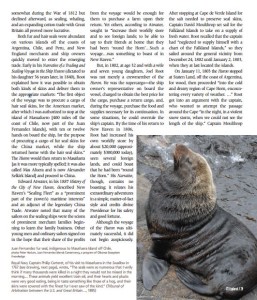 But, in 1802, at age 32 and with a wife and seven young daughters, Joel Root was not merely a crewmember of the Huron. He was the supercargo—the ship owner’s representative on board the vessel, charged to obtain the best price for the cargo, purchase a return cargo, and, during the voyage, purchase the food and supplies necessary for its continuation. In some situations, he could overrule the ship’s captain. By the time of his return to New Haven in 1806, Root had increased his own worldly store by about $20,000 (approximately $300,000 today), seen several foreign lands, and could boast that he had been “round the Horn.” His Narrative, though, contains no boasting; it relates his extraordinary adventures in a simple,matter-of-fact style and credits divine Providence for his safety and good fortune.
But, in 1802, at age 32 and with a wife and seven young daughters, Joel Root was not merely a crewmember of the Huron. He was the supercargo—the ship owner’s representative on board the vessel, charged to obtain the best price for the cargo, purchase a return cargo, and, during the voyage, purchase the food and supplies necessary for its continuation. In some situations, he could overrule the ship’s captain. By the time of his return to New Haven in 1806, Root had increased his own worldly store by about $20,000 (approximately $300,000 today), seen several foreign lands, and could boast that he had been “round the Horn.” His Narrative, though, contains no boasting; it relates his extraordinary adventures in a simple,matter-of-fact style and credits divine Providence for his safety and good fortune.
Although the voyage of the Huron was ultimately successful, it did not begin auspiciously. After stopping at Cape de Verde Island for the salt needed to preserve seal skins, Captain David Moulthrop set sail for the Falkland Islands to take on a supply of fresh water. Root recalled that the captain had “neglected to supply himself with a chart of the Falkland Islands,” so they sailed around the general vicinity from December 24, 1802 until January 2, 1803, when they at last located the islands.
On January 11, 1803 the Huron stopped at Staten Land, off the coast of Argentina, for wood, then proceeded “into the cold and dreary region of Cape Horn, encountering every variety of weather. …” Root got into an argument with the captain, who wanted to attempt the passage around the Cape “in the night, in a violent snow storm, when we could not see the length of the ship.” Captain Moulthrop finally relented and took the ship around the Horn three days later, reaching the island of Mocha on February 8.
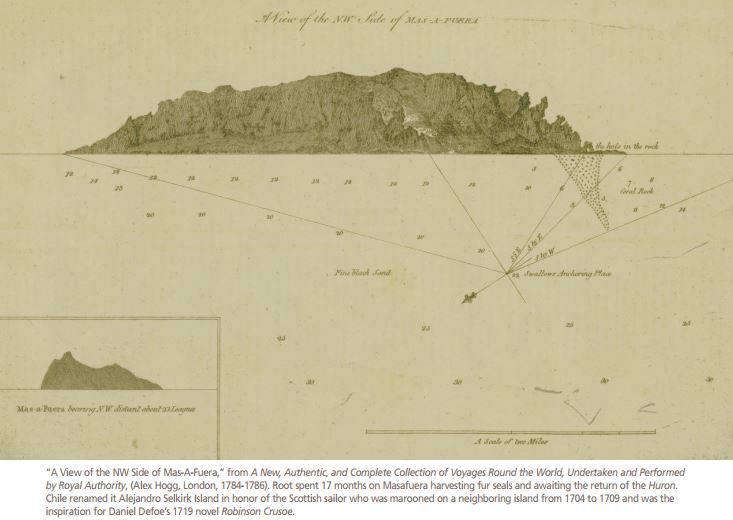 According to Root, “The islands of Mocha, St. Mary’s and the Lobos Islands were our principal dependence for hair seals.” Root and the captain went ashore on Mocha and discovered “…about twenty thousand [seals]lying in an eligible place to be taken.” The situation looked promising. The following day, Root and several other crewmembers set off by boat for the island to build a shelter to protect the salt and provisions needed for an extended stay. En route, however, the weather abruptly changed, and they were blown off course, losing sight of the ship “…in seas running mountains high.” They came ashore about 100 miles south of Concepcion, Chile, encountering natives of several local tribes, who bartered for or stole most of their belongings. After making their way to Concepcion, the men were reunited with the Huron, whose crew had been searching for them.
According to Root, “The islands of Mocha, St. Mary’s and the Lobos Islands were our principal dependence for hair seals.” Root and the captain went ashore on Mocha and discovered “…about twenty thousand [seals]lying in an eligible place to be taken.” The situation looked promising. The following day, Root and several other crewmembers set off by boat for the island to build a shelter to protect the salt and provisions needed for an extended stay. En route, however, the weather abruptly changed, and they were blown off course, losing sight of the ship “…in seas running mountains high.” They came ashore about 100 miles south of Concepcion, Chile, encountering natives of several local tribes, who bartered for or stole most of their belongings. After making their way to Concepcion, the men were reunited with the Huron, whose crew had been searching for them.
After this first misadventure, over the next 10 months, from February to October 1803, small parties of Huron crewmembers were deposited on Mocha, St. Mary’s, and Lobos islands and “procured” skins for the American market. Root did not describe the actual process of procuring a cargo of seal skins, but it involved killing herds of seals, skinning them, and salting them down to preserve them for transport. 18,000 hair seal skins were collected and stowed on board the Huron. With a full cargo, the ship sailed for New Haven on October 3, leaving Root and his party on the island of Masafuera for the next year and five months. During the ship’s absence, Root and the other men began harvesting the fur seal skins that would become the cargo on the ship’s voyage to China. In his understated way, Root described their work: “…the seals began to come (ashore) in small squads, so that we every day had something to do, though not always a full day’s work, but generally as much as we wanted. …” The Huron returned to Masafuera on March 7, 1805, the fur seal skins were loaded on board, and the ship set sail for Canton, with a brief stop at the Ambrose Islands and a two months’ stop at the Sandwich Islands (now Hawaii) “to wait for the change of the monsoons.”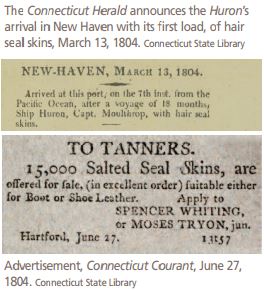
The Huron arrived in Canton on November 16, 1805, and Root sold its cargo of skins to the Hong Merchant Compqua and “…invested the proceeds in China goods (mostly green teas),” which did not constitute a full cargo. Unable to secure more cargo intended for America, Root instead took on sufficient freight for Hamburg, Germany, and departed Canton on January 7, 1806. The voyage to Hamburg was apparently an unintended detour necessitated by the lack of sufficient cargo for the American market.
The route to Hamburg took the ship around the Cape of Good Hope in Africa and back into the Atlantic Ocean. 165 dayslater, including a nine-day stay at the Island of St. Helena to take on a supply of water, Root and the Huron arrived in Hamburg on June 19, 1806. After unloading the cargo, they “…set sail for St. Petersburg, taking letters of credit, to purchase a cargo of Russian goods for the American market.”
On August 17, the Huron set sail for New York, with a cargo of iron, hemp, and dry goods, arriving on October 26. Four days later, Root returned to New Haven and had the “…inexpressible joy of finding my wife and children all in health, but the children so much altered that I should not have known them had I met them at any other place than their own mother’s fireside.” Root gave thanks to “the protecting hand of Providence” that sustained him “through all the varied scenes of peril I had passed.”
Root appears never to have gone to sea again. Perhaps he’d quenched his wanderlust or discovered he was more of a businessman than an adventurer. It is also possible that Root had no desire to endure another long stay on a desolate island, clubbing seals and hoping that his ship would return to retrieve him. He became a director of the Farmington Canal Company in 1823 (a risky venture itself that failed 20 years later; see “The Ill-Fated Farmington Canal,” Spring 2008) and in 1828 became the agent for the New Haven Steamboat Company, which ran boats between New Haven and New York, a position he held for many years.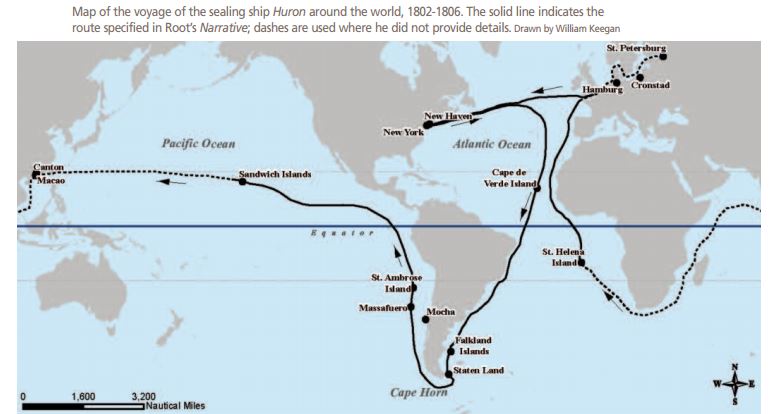 In 1840 Root dictated the story of his eventful voyage around the world in the Huron to one of his daughters. While time may have dimmed some of his recollections, his Narrative bears witness to the courage and determination of an early New Haven adventurer and entrepreneur.
In 1840 Root dictated the story of his eventful voyage around the world in the Huron to one of his daughters. While time may have dimmed some of his recollections, his Narrative bears witness to the courage and determination of an early New Haven adventurer and entrepreneur.
Dave Corrigan is the curator of the Museum of Connecticut History and a frequent contributor to CT Explored.
Explore!
Read more stories about Connecticut’s maritime history on our TOPICS page.

